In 3D Printing Information Briefs at the moment, we’re beginning with Desktop Metallic’s new PureSinter furnace. Then it’s on to analysis a few variable binder quantity algorithm and adaptive slicing, a 3D printing robotic that makes use of AI machine studying, and a 3D bioprinted liver mannequin for evaluating toxicity results. Lastly, WASP 3D printed ceramic constructions for a flower present’s sensory backyard, and NUMO showcased its 3D printed laborious hats and helmets in patriotic colours.
Desktop Metallic Debuts PureSinter Furnace at RAPID+TCT
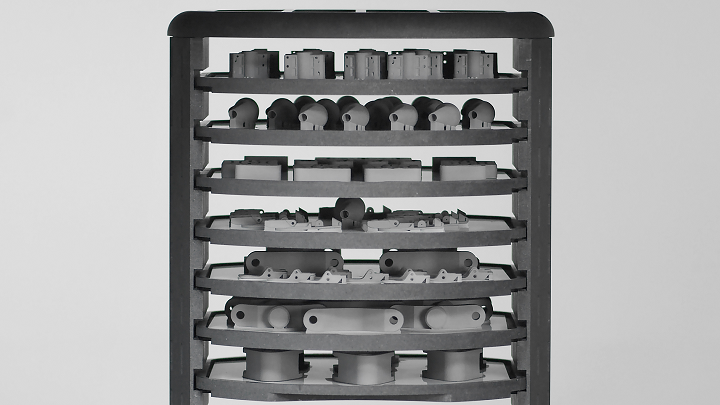
The PureSinter Furnace horizontal shelving system is manufactured from high-purity graphite and options seven cabinets in a 15.8L retort.
This week at RAPID+TCT 2024 in Los Angeles, Desktop Metallic had the worldwide debut of its new PureSinter, a high-purity vacuum furnace that provides one-run debinding and sintering of powder steel elements. The corporate has been growing this machine for 5 years to tackle the problem of sintering furnaces which are simply contaminated by hydrocarbons and different waste emitted by powdered steel elements. The PureSinter was designed for reliability, ease of use, excessive efficiency, and low price of operation. Its patent-pending design options greater than 17 followers and a pop-out ceiling vent, so it’s capable of cool from 1,420°C to 200°C in lower than 4 hours with out the usage of pricey water-cooled partitions. The PureSinter additionally has an environment friendly footprint, toughscreen controls, an automatic thermal hood elevate, and wonderful visibility inside its 15.8L retort. The system delivers parts-per-billion ranges of purity, is suitable with each conventional and additive manufacturing strategies, and has already been put in at FreeFORM Applied sciences.
“Quite than making an attempt to easily mitigate the elements that result in poor efficiency in an all-in-one debinding and sintering furnace, we now have eradicated them with an modern all-new design. That is the primary product from Desktop Metallic geared toward producers utilizing each Additive Manufacturing and conventional manufacturing strategies,” stated Ric Fulop, Founder and CEO of Desktop Metallic.
“We’ve got put the PureSinter via a protracted interval of testing to scrupulously confirm our new design, and it has exceeded all expectations. PureSinter is an exemplary demonstration of the innovation for which Desktop Metallic and our engineers are identified. We consider this furnace will revolutionize sinter-based AM and the normal furnace business.”
Normal shipments of the PureSinter Furnace, now validated with 14 steel powder and binder combos, ought to start in Q3 of 2024.
Turkish Researchers Optimizing Floor Roughness in Binder Jetting
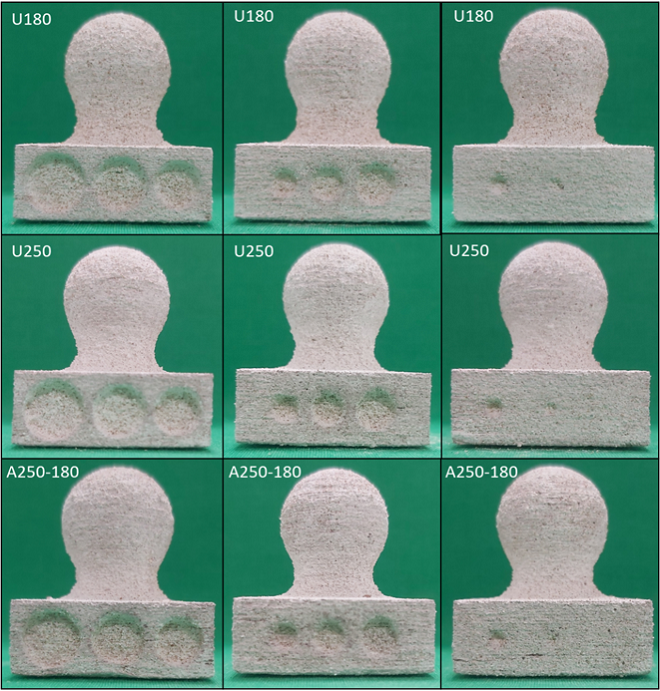
Final 12 months, a staff of researchers from Ondokuz Mayıs College in Turkey revealed a examine about rising the manufacturing velocity in binder jet 3D printing via the usage of adaptive slicing strategies, in addition to a variable binder quantity algorithm. As PhD researcher Hasan Baş defined in an e mail, their findings demonstrated particular enhancements in each floor high quality and optimization of manufacturing time. Baş reached out once more lately to tell us that the staff superior their preliminary analysis, specializing in utilizing the Taguchi technique and picture processing methods to optimize floor roughness. Additionally, adaptive slicing was once more used to extend manufacturing velocity, and the staff “demonstrated the applicability of those strategies to industrial binder jetting printers.”
“Adaptive slicing and variable binder quantity algorithm (VBAA) had been used to extend manufacturing velocity in binder jetting. Taguchi technique was used to optimize the layer thickness and saturation ratio in VBAA. In keeping with the Taguchi experimental design, 27 samples had been produced in 9 completely different situations, three replicates every. The width of the samples of their uncooked type was measured. Afterward, the samples had been sintered at 1,500 °C for two h. After sintering, floor roughness and density checks had been carried out. Due to this fact, the strategies used have been confirmed to achieve success. As well as, measurement potentialities with picture processing had been investigated to make floor roughness measurements extra accessible and extra economical,” the researchers wrote of their new examine.
Autonomous 3D Printing Robotic Utilizing AI Machine Studying
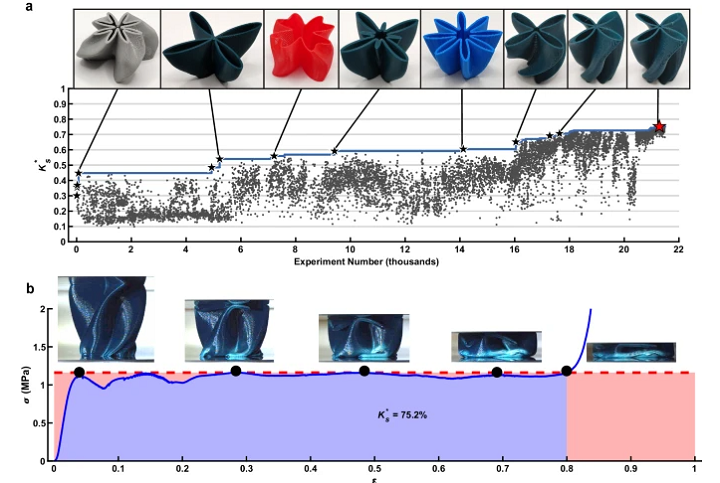
Determine 2: a) Every most vitality absorbing effectivity Ks* measured over the primary ~21,500 experiments carried out. Footage spotlight noteworthy elements (black stars) and the highest-performing construction (pink star). Bigger variations of photographs are included as Determine S11. The colour of the pictured elements is indicative of the fabric used, with Inexperienced indicating PLA, Blue indicating PETG, and Crimson/Grey indicating several types of TPU. The strong blue line denotes the operating finest Ks* noticed. b) Efficient medium stress σ vs. efficient medium pressure ε for experiment 21,285, named Palm, which resulted in Ks* = 75.2%. Inset images present the state of the part at varied factors indicated on the curve (photographs enhanced to enhance readability – originals given as Determine S12). Shading denotes areas used to compute Ks* as described in Fig. 1a.
An automatic experiment has been occurring on the KABlab at Boston College since 2021, run by Keith Brown, an ENG affiliate professor of mechanical engineering, and his staff. An autonomous robotic arm, referred to as MAMA BEAR (Mechanics of Additively Manufactured Architectures Bayesian Experimental Autonomous Researcher), repeatedly 3D prints small, plastic elements, after which data their measurement and form, strikes them to a flat steel plate, and crushes them. It measures and data how a lot vitality the construction absorbed, and the way its form modified, earlier than dropping it right into a field on the ground, cleansing the plate, and printing one other piece, which will likely be just a bit completely different than the final. MAMA BEAR does all of this via AI machine studying, and every time, the construction will get higher at absorbing its crushing affect. Not too long ago, the staff watched the robotic attain 75% effectivity—breaking the document of 71%—with a 3D printed construction that includes 4 factors, formed like flower petals, that’s taller and narrower than early designs.
“Right here, we discover the vitality absorbing effectivity of additively manufactured polymer constructions by utilizing a self-driving lab (SDL) to carry out >25,000 bodily experiments on generalized cylindrical shells. We use a human-SDL collaborative strategy the place experiments are chosen from over trillions of candidates in an 11-dimensional parameter house utilizing Bayesian optimization after which mechanically carried out whereas the human staff displays progress to periodically modify facets of the system. The results of this human-SDL marketing campaign is the invention of a construction with a 75.2% vitality absorbing effectivity and a library of experimental knowledge that reveals transferable ideas for designing powerful constructions,” the researchers wrote within the summary of their revealed paper.
A number of the staff members are actually working with the U.S. Military to make use of their knowledge to tell the design of recent helmet padding for troopers.
3D Bioprinted Mobile Liver Fashions for Measuring Toxicity Results
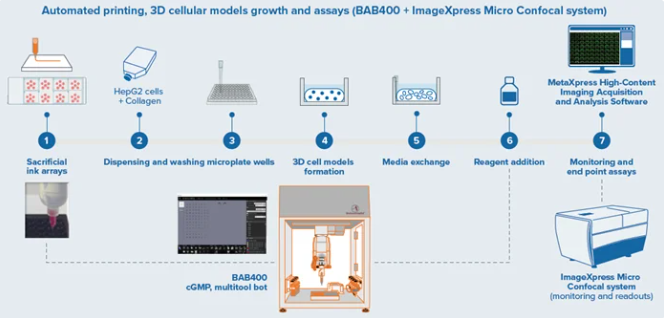
Determine 1. BAB400 3D printing and meting out workflow built-in with Imager for endpoint assays. Picture Credit score: Molecular Gadgets UK Ltd
Talking of robots, Superior Options and Molecular Gadgets labored collectively to develop a way for automated era of 3D mobile liver fashions, with a view to take a look at and consider the toxicity results of assorted compounds. This was completed utilizing the BioAssemblyBot 400 (BAB400), a cGMP-certified multi-tool bioprinting robotic system with liquid dealing with. The BAB400 used tissue construction data modeling (TSIM) software program to design 3D constructions for bioprinting, and the robotic additionally automated meting out, imaging, and upkeep of the 3D fashions. The ImageXpress Micro Confocal HighContent Imaging System was used to achieve transmitted mild (TL) and fluorescent photographs. Utilizing the system’s confocal mode, Z-stack photographs of liver cells inside a collagen matrix had been acquired with 4X or 10X goals for the liver tissue fashions.
In the end, the BAB400 and TSIM software program had been capable of develop 3D HepG2 human liver most cancers cell fashions in 96 nicely codecs, which had been then cultured and monitored day by day. After 4 days, a number of of the nicely plates had been handled with a number of medication for 48 hours and the cells had been stained and analyzed. These had been in contrast with 2D HepG2 liver most cancers cell fashions. After evaluating the 2D and 3D HepG2 assays, compound results had been discovered at decrease concentrations in 2D methods than in 3D. The outcomes display that it’s useful to make use of an automatic technique, just like the BAB400, in forming liver 3D bioprinted fashions, and in addition discovered advantages to utilizing imaging and knowledge evaluation strategies and descriptors to study extra concerning the complicated compound results in each kinds of cell fashions.
3D Printed Sensory Ceramic Backyard for World Little one Most cancers UK

RHS Chelsea Flower Present Giulio Giorgi WASP. Picture supplied by Telegraph, Man Bell/Alamy.
Italian panorama designer and gardener Giulio Giorgi needed to create one thing very particular for the 2024 RHS Chelsea Flower Present. In collaboration with World Little one Most cancers UK and WASP, and with funding from Undertaking Giving Again, they constructed “World Little one Most cancers’s Nurturing Backyard,” a 3D printed ceramic sensory backyard to help the emotional wellbeing of younger most cancers sufferers and their households. Giorgi needed a backyard that could possibly be simply replicated, and was adaptable to a wide range of environments and climates, so it could possibly be reproduced in different hospitals. Giorgi and Professor Giuseppe Fallacara of the Polytechnic College of Bari designed a stackable ceramic module for final customization, and WASP’s clay 3D printing farm—utilizing the automated WASP 40100 Manufacturing system—printed a collection of the modules with personalised designs. As soon as these had been full, Landesigns Ltd assembled the backyard, which additionally ended up profitable the gold medal in sustainability on the RHS Chelsea Flower Present.
Malcolm Anderson, the Royal Horticultural Society’s head of sustainability, stated, “The backyard has been made utilizing merchandise made totally from soil and timber and in its building no energy instruments have been used, solely hand instruments, so it’s a tremendous instance of how we are able to design and construct gardens extra sustainably sooner or later.”
NUMO’s 3D Printed Exhausting Hats and City Helmets
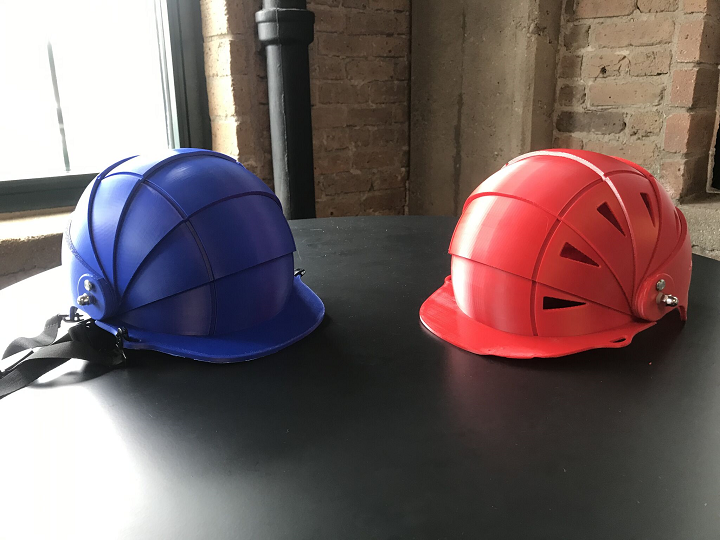
Lastly, on Memorial Day within the U.S., Numorpho Cybernetic Techniques (NUMO) showcased its 3D printed laborious hats and concrete helmets in pink and blue in honor of “the uncountable lives of our front-line troopers which have made our nation free and secure.” The corporate, which bought its begin at mHUB in Chicago, builds good, linked, and sustainable merchandise that may improve our present capabilities, allow residing past our constraints, and even ultimately evolving options that may make methods extra conscious, coordinated, and clever. They used ABS, which is stronger and affect resistant, to print the blue helmets, and PETG, extra versatile and shatter-resistant, to print the pink ones. In one of many feedback on his LinkedIn put up, NUMO’s Founder and CEO Nitin Uchil stated the helmets are customizable, and that the corporate is understanding take level cloud knowledge from a head scan and “convert it to get the 42 management factors which are wanted to outline the customized form in order that we are able to match it for anybody.”
“When doing affect testing for helmets, it not simply how sturdy the fabric is, but in addition the way it muffles the shock of the blow and prevents or minimizes harm to the top,” Uchil wrote on LinkedIn. “It additionally is determined by the froth/versatile padding, the match of the retainers and suspensions, and the chin strap that may forestall the detachment of the helmet on affect that play key elements in security. We may even be conducting digital simulations of the affect take a look at to see if we are able to modify the infill lattice construction to have areas of variable density to match up with the wants to withstand affect whereas optimizing the load of the helmet.”
The corporate plans to maneuver quickly to the following section of commercialization for its helmets: small batch manufacturing and take a look at validation for security normal certifications.
Subscribe to Our Electronic mail E-newsletter
Keep up-to-date on all the most recent information from the 3D printing business and obtain data and presents from third occasion distributors.

